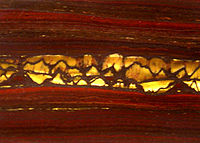 Jade (do francês jade; em espanhol piedra de la ijada, "pedra do
flanco") é uma pedra ornamental muito dura e compacta, variando, na cor,
de esbranquiçada a verde-escura. Designa a associação de dois minerais, a forma
em nefrita da actinolite e um mineral chamado jadeíta. É geralmente empregada em
objetos de adorno, em estatuetas etc.
Jade (do francês jade; em espanhol piedra de la ijada, "pedra do
flanco") é uma pedra ornamental muito dura e compacta, variando, na cor,
de esbranquiçada a verde-escura. Designa a associação de dois minerais, a forma
em nefrita da actinolite e um mineral chamado jadeíta. É geralmente empregada em
objetos de adorno, em estatuetas etc.
História
 Jade é um nome que era aplicado às pedras ornamentais que eram
trazidas à Europa da China e da América central. Somente em 1863 se percebeu
que o termo "jade" estava sendo aplicado a dois minerais diferentes.
A jadeíta quase nunca é encontrada
em cristais individuais e é composta dos cristais bloqueando microscópicos que
produzem um material muito resistente. Nefrita é realmente um não-mineral, mas uma variedade da actinolita mineral. A variedade de nefrita é composta de cristais
fibrosos entrelaçados em uma massa compacta resistente. Outras variedades de actinolita são completamente
diferentes da nefrita. A dureza do jade é notável. Tem uma resistência maior do que o
aço e é posto para trabalhar por muitas civilizações adiantadas para machados,
facas e armas. Estava mais atrasado que o jade se transformou uma pedra
simbólica usada nos ornamentos e outros artefatos religiosos durante os éons. O jade é valioso ainda
hoje por sua beleza. Suas muitas cores são apreciadas, mas a cor
verde-esmeralda que a jadeíta produz assim bem, que está sendo altamente procurado por coletores
da arte-final. Este jade verde-esmeralda, chamado "jade imperial", é
colorido pelo cromo. Outras cores são influenciadas pelo ferro (verde e marrom)
e o manganês é pensado para produzir as cores violetas. A nefrita é geralmente branco, verde
e creme, quando a jadeíta puder ter a escala cheia de cores do jade. É usada nas medalhas
olímpicas.
Jade é um nome que era aplicado às pedras ornamentais que eram
trazidas à Europa da China e da América central. Somente em 1863 se percebeu
que o termo "jade" estava sendo aplicado a dois minerais diferentes.
A jadeíta quase nunca é encontrada
em cristais individuais e é composta dos cristais bloqueando microscópicos que
produzem um material muito resistente. Nefrita é realmente um não-mineral, mas uma variedade da actinolita mineral. A variedade de nefrita é composta de cristais
fibrosos entrelaçados em uma massa compacta resistente. Outras variedades de actinolita são completamente
diferentes da nefrita. A dureza do jade é notável. Tem uma resistência maior do que o
aço e é posto para trabalhar por muitas civilizações adiantadas para machados,
facas e armas. Estava mais atrasado que o jade se transformou uma pedra
simbólica usada nos ornamentos e outros artefatos religiosos durante os éons. O jade é valioso ainda
hoje por sua beleza. Suas muitas cores são apreciadas, mas a cor
verde-esmeralda que a jadeíta produz assim bem, que está sendo altamente procurado por coletores
da arte-final. Este jade verde-esmeralda, chamado "jade imperial", é
colorido pelo cromo. Outras cores são influenciadas pelo ferro (verde e marrom)
e o manganês é pensado para produzir as cores violetas. A nefrita é geralmente branco, verde
e creme, quando a jadeíta puder ter a escala cheia de cores do jade. É usada nas medalhas
olímpicas.Meet Natural Stone-Jade
Jade ( Jade French , Spanish piedra de la ijada , " stone edge " ) is a very hard and compact ornamental stone , varying in color from white to dark green . Means the combination of two minerals, nephrite in the form of a mineral called actinolite and jadeite . It is usually used in decorative objects , figurines etc on .
history
Jade is a name that was applied to ornamental stones that were brought to Europe from China and Central America. Only in 1863 it was realized that the term " jade" was being applied to two different minerals . The jadeite is almost never found in individual crystals and is composed of microscopic crystals blocking that produce a very durable material . Nephrite is actually a non - mineral, but a variety of the mineral actinolite . The nephrite variety is composed of fibrous crystals woven into a tough compact mass . Other varieties of actinolite are completely different from nephrite . The hardness of jade is remarkable. Has a greater resistance than steel and is put to work by many early civilizations for axes, knives and guns . It was later that jade became a symbolic stone used in ornaments and other religious artifacts during the eons . Jade is still valuable for its beauty . Its many colors are appreciated , but the emerald green color that jadeite produces so well, being highly sought after by collectors of artwork . This emerald green jade called " Imperial Jade " is colored by chromium. Other colors are influenced by iron ( green and brown ) and manganese is thought to produce the violet colors . The nephrite is generally white, green and cream , when jadeite can have the full range of colors of jade . It is used in Olympic medals .









































